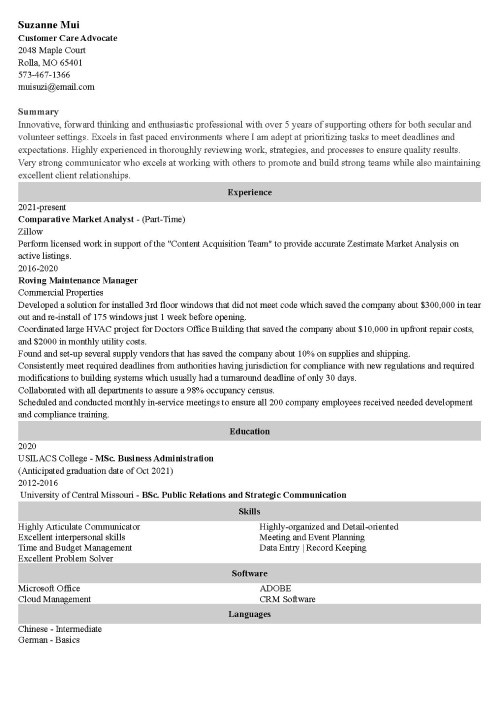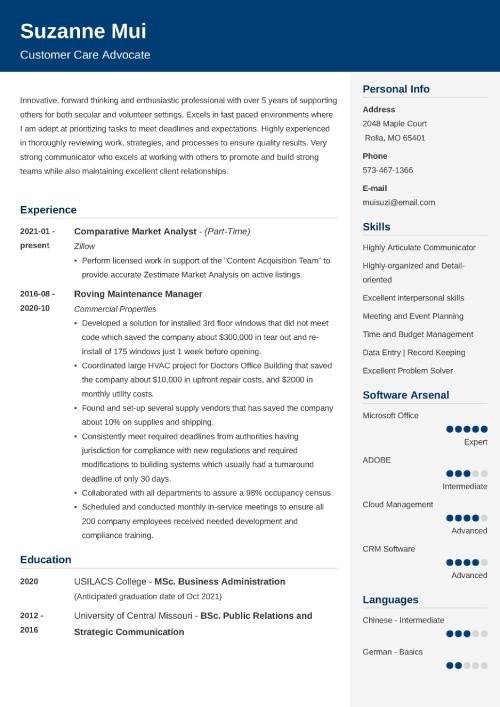
How to List Continuing Education on a Resume? 10+ Examples
Adding continuing education on a resume can set you apart from a crowd of 250+ candidates. Just make sure you do it right, and show you’re serious about your career development.
It’s no secret: the strength of your resume depends on your experience and skills. But it would be a lie to say that the other sections don’t count at all. Because they do.
More than that: including certain extra sections in your resume can easily earn you extra points. And continuing education is one of them.
This article will show you:
- What continuing education is.
- How to list professional development on a resume.
- Examples of continuing education on a resume.
Want to save time and have your resume ready in 5 minutes? Try our resume builder. It’s fast and easy to use. Plus, you’ll get ready-made content to add with one click. See 20+ resume templates and create your resume here.
Sample resume made with our builder—See more resume examples here.
Learn how to make the most of your education on a resume with our guides:
- How to Make a Resume
- What to Include in a Resume
- How to Put Your Education on a Resume
- Cum Laude on a Resume
- How to List a Degree on a Resume
- How to Put Dean's List on a Resume
Are you looking for a dedicated resume writing guide? We’ve got you covered:
- Accounting Resume
- Engineering Resume
- Medical Resume
- Nursing Resume
- Attorney Resume
- Paralegal Resume
- Teacher Resume
How to list continuing education on a resume?
Continuing education should be listed in the education or professional development section of your resume. This information is usually comes last. To save space, you can list continuing education under the Education & Professional Development section title.
But let's look at these options in greater detail now—
1
Continuing Education. What Is This?
First things first—
What is continuing education?
The term continuing education is commonly used in the US and Canada to refer to any kind of adult education that happens after leaving the formal education system.
In other words, continuing education refers to any courses you take and/or certifications you acquire once you start your professional life.
In fact, professional development is another word for continuing education on a resume.
Now—
For some professions, listing continuing education on a resume is a nice-to-have.
For example, an online marketer could easily add a search engine marketing certification to their resume, but it’s not obligatory. You can be great at SEM without any certification.
Some professions, however, are under an obligation to earn continuing education units (CEUs) or continuing education credits (CECs) to maintain their professional licenses and stay employable, for example:
- Accountants
- Engineers
- Health care professionals
- Legal professions
- Pilots
- Teachers
The representatives of these professions should list continuing education on a resume.
Pro Tip: When making your resume use resume action words to impress the recruiters and go past the ATS scan.
2
How to List Professional Development on a Resume
It’s a good idea to create a dedicated continuing education resume section.
You can label it professional development, training and development, certifications, licenses, or simply continuing education on a resume.
There are no specific rules on what your resume’s continuing education includes.
So—
It’s a good section to put professional certifications or online courses on a resume, alongside any other forms of professional learning and development programs or courses you’ve taken.
Truth be told:
Once you create a continuing education resume section, the only dilemma you may face would concern where to put this section on your resume.
The rule of thumb is that the more experience you have the higher up your experience section should end up on your resume.
The education resume section should only top your resume if you’re making an entry-level resume, or a student resume.
In all other cases, place your education section as well as continuing education on a resume below the experience section.
And one more thing—
Don’t treat the professional development resume section as a dumping ground for all the courses you’ve ever taken.
Focus on what’s relevant to the position you’re after, and tailor your resume to the job offer.
Also, once you pick out the things to include in your continuing education on a resume sort the items either by relevance or date.
Put your most relevant courses/licenses up top. Or, list the most recent courses first.
In general, the reverse-chronological resume format is your safest bet.
Pro Tip: You can also mention continuing education in your cover letter. Learn how to write a cover letter that every recruiter will read from beginning to end.
When making a resume in our builder, drag & drop bullet points, skills, and auto-fill the boring stuff. Spell check? Check. Start building a professional resume template here for free.
When you’re done, Zety’s resume builder will score your resume and tell you exactly how to make it better.
3
How to List Continuing Education on a Resume— Examples
Finally—
Take a look at some examples of how to list continuing education on a resume:
Accounting
Certifications
- CFA
- CIS
Engineering
License
- Licensed California Professional Engineer
Nursing
Licenses and Certifications
- Registered Nurse (Licence #1234567
- ACLS
- BCLS
- CCRN
- CPR
Legal professions (Attorney)
Professional development
- Member in good standing of the Florida State Bar
- Labor Law and Labor Arbitration Conference 2018—Speaker
Pilot
Learning and Development
- Flight time (total): 8,534
- ATP Certificate
- ASEL Certification
- FAA Class 1 Medical
Pro Tip: Format your resume consistently, and use professional-looking, readable resume fonts.
Depending on your professional background and job requirements, you’ll want to put different things under the heading professional development on your resume.
As a matter of fact, you may opt for including other resume sections or choosing a different kind of resume, such as combination resume, or functional resume.
Plus, a great cover letter that matches your resume will give you an advantage over other candidates. You can write it in our cover letter builder here. Here's what it may look like:
See more cover letter templates and start writing.
Key Takeaways
Here’s a quick rundown of all you need to know about how to list continuing education on resume:
- You can say that professional development is another word for continuing education on a resume.
- For some professions (e.g. marketers) adding continuing education on a resume is optional.
- Certain jobs (e.g. pilots, attorneys, nurses) are under an obligation to earn continuing education credits to stay employable and be able to pursue their careers.
- Either way, including continuing education on a resume, can boost your chances of landing a job.
- Use a separate resume section to list continuing education on your resume.
- Make sure the courses, licenses, or training you put there is relevant to the position you’re applying for.
Do you have any questions about how to list continuing education on a resume? Maybe you’d like to share some advice? Give us a shout out in the comments below. We’d love to hear from you!




